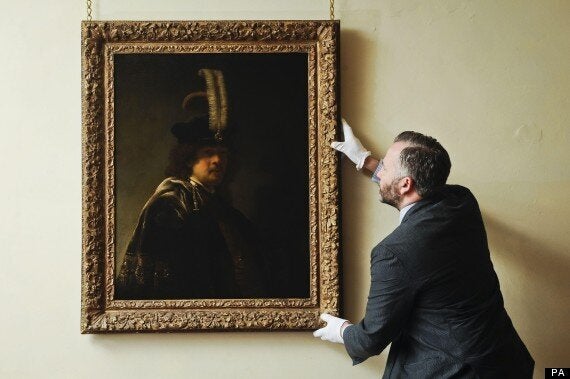A painting hanging in the former home of Sir Francis Drake has been confirmed as a self-portrait by the Dutch Master Rembrandt, the National Trust has announced.
For decades the picture, which has been at Buckland Abbey in Devon since it was given to the trust in 2010, was thought to have been a portrait produced by one of Rembrandt's pupils.
But years of studying the 17th-century artist's style and a new investigation of the painting by the world's leading Rembrandt expert, Ernst van de Wetering, has re-attributed the painting as a work by the Dutch Master himself.

Curator of Pictures and Sculpture David Taylor inspects a confirmed self-portrait of Rembrandt
The painting, kept in storage for the first 18 months it was at Buckland Abbey as there was nowhere to hang it, is now one of the National Trust's most important.
It has been given a value of £20 million, although as the trust holds items on behalf of the nation forever, the organisation said it can never be sold.
The painting was given to the National Trust as a gift from the estate of the late Edna, Lady Samuel of Wych Cross, whose husband Harold, Lord Samuel of Wych Cross, collected a great number of paintings during his lifetime.
The self-portrait showing Rembrandt aged 29, "signed" by the Dutch Master and dated 1635, previously belonged to the Princes of Liechtenstein.
Its provenance had been shrouded in mystery for 40 years, after Rembrandt specialist Horst Gerson suggested in 1968 that it may well have been painted by one of Rembrandt's pupils. In the same year members of the Rembrandt Research Project inspected the painting and came to the same conclusion, publishing their findings in 1989.
Mr van de Wetering, Dutch art historian and chairman of the Rembrandt Research Project, said that based on what was known of the painter's style in 1968, experts decided it was most likely to have been painted by one of his pupils.
"But over the past 45 years we have gathered far more knowledge about Rembrandt's self-portraits and the fluctuations in his style," he said.
An analysis by Mr van de Wetering, based on an X-ray of the painting published in 2005 and newly found circumstantial evidence, increased the likelihood it was by Rembrandt himself.
Mr van de Wetering went to Buckland Abbey to look again at the painting, and said he saw the same crude brushwork and painting technique observed in other Rembrandt pictures of that period, leading to the conclusion it was by the Dutch Master.
Jez McDermott, National Trust property manager at Buckland Abbey, said: "It's amazing to think we might have had an actual Rembrandt hanging here on the walls at Buckland Abbey for the past couple of years. We never dared think it might actually be an original, and many of our visitors will have just passed by it in what is sure to be a real contrast to the attention it is now going to receive."
David Taylor, curator of paintings and sculpture at the National Trust, said: "Rembrandt was one of the great artists of the so-called Dutch golden age. He produced a huge number of self-portraits throughout his career, partly because he had a ready subject matter in himself, through which he could develop his painting technique but also because, as he was already famous, the finished images were highly desirable pictures for collectors.
"This portrait is now one of our most important works of art and will be the only Rembrandt in the National Trust's collection of approximately 13,500 paintings."
The painting will hang in Buckland Abbey for another eight months before being sent for cleaning and further examination to shed more light on its attribution.
A full technical analysis, funded by £20,000 from the People's Postcode Lottery, will include x-rays, examination of paint pigments, infrared testing to examine any drawing under the painting and tree-ring dating of the beech panel it is painted on.